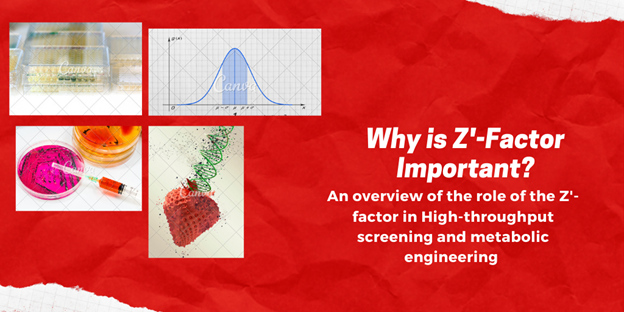
Legend: The recent push for sustainability has brought metabolic engineering and its applications for providing alternatives to food, medicine, and biodegradable materials. With the use of high-throughput sequencing and the interpretation of data using the Z’-factor, metabolic engineering can be improved to increase efforts toward a more sustainable world. The pictures represent High-throughput assays being carried out, normalized data being generated and interpreted, cultures being grown with the approved screens, and lastly, an image of the modification of genomes to provide more sustainable food. Images were obtained with Canva.
Introduction:
With the population increasing, sustainability is at the forefront of the priority list for this generation’s scientific advances. Metabolic engineering has used yeast to provide meat alternatives, create biodegradable plastic, and synthesize opioids. High-throughput technology and its ability to optimize the determination of specific pathways which increase productivity is going to prove crucial to the future development of more alternatives to create the sustainability that the world needs. With the research that comes from this High-throughput screening, comes the need for the Z’-factor. The Z’-factor is a statistical method that can be used in High-throughput screening to determine the statistical effect of the experiment using only the controls1.
Background:
When talking about the Z’-factor, it is important to also talk about the Z-factor. The Z-factor is defined by Equation 1, or in the rearranged form in Equation 2, where μs is the mean of the library sample’s signal, μc is the mean of the control, σs is the standard deviation of the sample signal, and σc is the standard deviation of the control1. The Z-factor serves to evaluate the quality of a high-throughput assay1. Similar to the Z-factor is the Z’-factor, which can also evaluate the quality of a High-throughput assay but can be calculated exclusively with the control data. The Z’-factor is defined in Equation 3, where the +/- on the previously defined coefficients indicate whether the term represents the positive or negative control in the High-throughput assay itself. Both the Z-factor and the Z’-factor are only meaningful within the range -1<Z ≤1, with the quality of the Z or Z’-factor increasing as they approach 1, generally a Z or Z’-factor value greater than 0.5 is considered high enough1. It should be noted that in any case, as long as the positive and negative controls are appropriate, and the data set is large enough, the Z-factor will always be smaller than the Z’-factor1. The use for the Z’-factor lies in the quality determination during the developmental phase before the experimental phase due to it using the controls.

Knowing how to obtain the Z’-factor is only important though if it is interpreted correctly, and the practicality of it can be seen. Raphemot, Weaver, and Denton utilized the Z’-factor in their research on High-throughput screening for small molecule modulators of inward rectifier K+ channels2. When performing their assays, they were performed on separate days, and a Z’-factor of at least Z’=0.5 was needed on 3 separate days to be considered suitable for continuing with High-throughput screening2.
High-throughput screening has opened a new realm of efficiency for determining pathways that could be further observed for creating sustainability3. This work would not be as meaningful though without the statistical significance that can be suggested from the Z’-factor. The use of this statistical method in high-throughput screening could result in lower costs for the screening of optimal metabolic engineering pathways which can be optimized for the desired product, whether it be food alternatives, medical alternatives, or biodegradable plastics.
Limitations:
While useful for quality determination in High-throughput assays, the Z’ -factor has its limitations. One issue with the Z’-factor is that it is possible to generate a high Z’-factor by using a strong positive control which may not realistically represent more moderate screening positives4. If less extreme conditions, which are likely to be the conditions of the high-throughput screening experiment, are put into place, the chance is that in certain situations the experimental values are not close enough to the Z’ values, leading to misconstrued data. This is a concern working with methods such as RNA interference (RNAi), stated by Birmingham et. al. in their description of high-throughput screening’s importance for RNAi in reverse genetics and drug discovery.
References:
- Zhang J-H, Chung TDY, Oldenburg KR. A Simple Statistical Parameter for Use in Evaluation and Validation of High Throughput Screening Assays. Journal of Biomolecular Screening. 1999;4(2):67-73. doi:1177/108705719900400206
- Raphemot, R., Weaver, C. D., Denton, J. S. High-throughput Screening for Small-molecule Modulators of Inward Rectifier Potassium Channels. J. Vis. Exp. (71), e4209, doi:10.3791/4209 (2013).
- Reinzo, M., Jackson, S. J., Chao, L. K., Leaf, T., Schmidt, T. J., Navidi, A. H., Nadler, D. C., Ohler, M., & Leavell, M. D. (2021). High-throughput screening for high-efficiency small-molecule biosynthesis. Metabolic Engineering, 63, 102–125. https://doi.org/10.1016/j.ymben.2020.09.004
- Birmingham, A., Selfors, L. M., Forster, T., Wrobel, D., Kennedy, C. J., Shanks, E., Santoyo-Lopez, J., Dunican, D. J., Long, A., Kelleher, D., Smith, Q., Beijersbergen, R. L., Ghazal, P., & Shamu, C. E. (2009). Statistical methods for analysis of high-throughput RNA interference screens. Nature methods, 6(8), 569–575. https://doi.org/10.1038/nmeth.1351